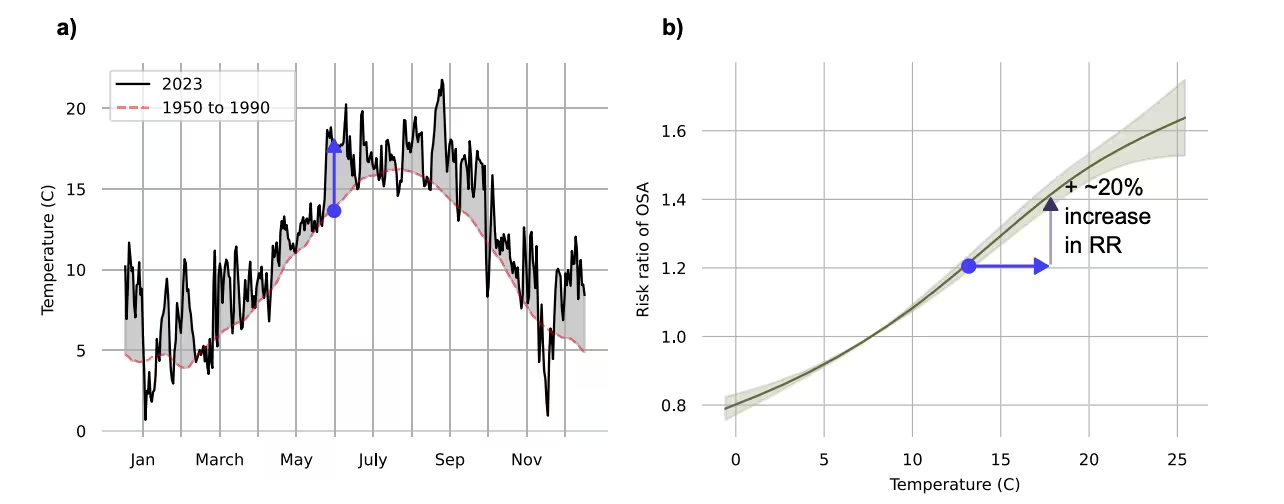4 Minutes
Climate Change and the Surge in Obstructive Sleep Apnea
As global temperatures continue to rise, a significant public health concern is emerging: the prevalence of obstructive sleep apnea (OSA) is set to increase sharply. According to new scientific research, higher nighttime temperatures linked to climate change could increase the risk of OSA by up to 45% by the end of this century. This escalation poses challenges not only for individual health and wellbeing but also for societal productivity and economic stability.
The Science Behind Obstructive Sleep Apnea and Environmental Factors
Obstructive sleep apnea is a common sleep disorder affecting roughly one billion people worldwide. It occurs when the airway becomes repeatedly blocked during sleep, causing breathing to stop for at least 10 seconds multiple times each hour. Many individuals with OSA remain undiagnosed, yet the condition disrupts the balance of oxygen and carbon dioxide in the blood, diminishes sleep quality, and can lead to severe long-term health consequences. In a recent study led by Dr. Bastien Lechat at Flinders University, Australia, researchers uncovered a robust link between escalating night-time temperatures and the severity of OSA. "This study highlights how environmental factors such as climate can directly affect human health," Dr. Lechat notes, emphasizing the impact of rising ambient temperatures on sleep disorders.
Methods: Leveraging Big Data and Sleep Technology
The research team analyzed anonymized sleep data from 116,620 participants in 29 countries, collected between January 2020 and September 2023. Each subject used an advanced under-mattress sleep sensor capable of tracking movement and breathing patterns for approximately 500 nights per person. To assess the correlation with environmental factors, researchers combined this sleep data with detailed 24-hour local temperature records from each participant’s city.
The year 2023 marked a significant milestone for the study: it was the hottest year ever observed, with global mean temperatures rising 2.07 °C above pre-industrial levels. The researchers found that individuals exposed to higher nighttime temperatures were 45% more likely to experience episodes of OSA on any given night.

Public Health Consequences and Economic Impact
The implications of increasing sleep-disordered breathing are profound. OSA has been linked to metabolic disruptions like impaired glucose regulation, cognitive and mood disturbances, and heightened cardiovascular risks, including heart failure and stroke. Chronic or untreated cases elevate the risk for severe outcomes such as dementia, neurological diseases, traffic accidents, and premature mortality. In 2023 alone, the global surge in OSA cases due to warming temperatures led to a loss of approximately 800,000 healthy life years across the studied nations—a burden comparable to Parkinson’s disease or chronic kidney disorders.
The societal costs are staggering. The authors estimate that the productivity lost due to sleep apnea—measured as 105 million days of workplace absenteeism—amounts to nearly $98 billion USD, effectively doubling the current societal burden of the disorder.
Regional Variation and Social Disparities
The study uncovered notable regional disparities. European countries registered a stronger correlation between temperature increases and sleep apnea prevalence than nations such as Australia and the United States, likely due to differing rates of air conditioning use and access to climate-controlled environments. Importantly, because the sleep tracking technology was more widely used in high-income regions, the study may actually underestimate the global burden, particularly in lower socioeconomic communities with less access to temperature regulation and healthcare.
Looking Ahead: Mitigating Climate-Driven Health Challenges
Projections suggest that without drastic reductions in greenhouse gas emissions, global average temperatures could rise by 2.1–3.4 °C by 2100. The authors warn that such a scenario would further amplify the health and economic toll of sleep apnea, potentially doubling its worldwide prevalence.
As Dr. Lechat concludes, "The magnitude of these health and economic impacts underscore the urgency of addressing both sleep health on an individual level and climate change as a global challenge."
Conclusion
The intersection of climate change and public health is increasingly apparent, with rising temperatures posing a direct threat to global sleep quality and overall wellbeing. The anticipated 45% surge in obstructive sleep apnea by century’s end highlights the need for integrated strategies encompassing environmental policy, advances in sleep medicine, and increased public awareness. Addressing this dual crisis will be essential for safeguarding both societal health and economic productivity in a warming world.
Source: doi



Comments